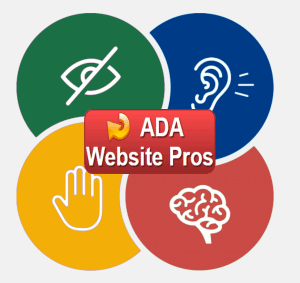A.D.A. Compliant Websites Design and Development
Table of Contents
A Brief Introduction to Web Accessibility
While there are a lot of disabilities and conditions that can affect the way people use websites, let’s take a look at some of the most common categories of impairments:
Vision
Hearing
Motor Skills
Photosensitive seizures
Cognitive disabilities
10 Ways to Make Your Website Accessible

1. Make Sure Your Site Is Keyboard-Friendly
This step is also the most important. Put simply: for a website to be accessible, it must work without the use of a mouse. This is because many assistive technologies rely on keyboard-only navigation. As such, it must be possible to use all of your site’s major features via a keyboard and nothing else. This includes accessing all pages, links, content, and so on.
2. Make Sure All Content Is Easily Accessible
In addition to making your site keyboard-friendly, you also need to ensure that all content on the page is actually accessible. While this is usually not a problem, it can be an issue when a page contains dynamic content.
3. Add Alt Text to All Images
Alt text (sometimes called alt attributes, alt descriptions, or alt tags) is also accessed by screen readers to ‘read’ the picture. You can therefore use this field to describe an image, giving context to users who would otherwise miss it.
4. Choose Your Colors Carefully
9% of men have some form of colorblindness. We should think about this when designing a site!
5. Use Headers to Structure Your Content Correctly
Another key task to make your site accessible is structuring your content by using headers carefully. Doing this will make your content much easier to understand and digest and improves flow.
6. Design Your Forms for Accessibility
Forms are a useful addition to most sites but must be designed carefully. What’s most important is to ensure that each field is clearly labeled. You should also aim to place the labels adjacent to the respective fields. While a sighted user can easily match a label to the corresponding field or option, this may not be obvious for someone using a screen reader.
7. Don’t Use Tables for Anything Except Tabular Data
When it comes to displaying data, tables are handy. They make it much easier for all users, including those using assistive technology, to parse a large amount of data. To get the maximum benefit, however, you’ll want to keep your tables as simple as you can.
8. Enable Resizable Text That Doesn’t Break Your Site
Most devices and browsers will enable users to resize text, which can be helpful for those with visual impairments. However, if you don’t build your site to support this feature, resizing text could break your design or make it difficult to interact with your site.
10. Create Content With Accessibility in Mind
Finally, we come to the core of your site: its content. While designing your site for accessibility is hugely important, you should bear the same considerations in mind when creating content.


Websites For All
By taking the time to understand the possible flaws in your design and content, you can make sure your site is optimized for accessibility today.

ADA Website Questionnaire
FELIPE FERNANDEZ v. URBAN OUTFITTERS, INC.
Plaintiff Name: FELIPE FERNANDEZ Filing date: December 31, 2024 State of filing: New York Defendant Name: URBAN OUTFITTERS, INC. Website: www.shopterrain.com Industry: Retailing Summary: Terrain, founded in 2008, transforms garden centers into nature celebrations....
JACQUELINE FERNANDEZ v. SPARTAN RACE, INC.
Plaintiff Name: JACQUELINE FERNANDEZ Filing date: December 31, 2024 State of filing: New York Defendant Name: SPARTAN RACE, INC. Website: www.spartan.com Industry: Consumer Services Summary: Spartan is the world's largest obstacle race and endurance brand, offering a...
JACQUELINE FERNANDEZ v. 4PATRIOTS, LLC
Plaintiff Name: JACQUELINE FERNANDEZ Filing date: December 31, 2024 State of filing: New York Defendant Name: 4PATRIOTS, LLC Website: www.4patriots.com Industry: Food & Staples Retailing Summary: 4Patriots is a company dedicated to championing freedom and...
FELIPE FERNANDEZ v. BLOOMSCAPE, INC.
Plaintiff Name: FELIPE FERNANDEZ Filing date: December 31, 2024 State of filing: New York Defendant Name: BLOOMSCAPE, INC. Website: www.bloomscape.com Industry: Retailing Summary: Bloomscape specializes in delivering a wide variety of indoor plants directly to...
9042 Garfield Ave #205c
Huntington Beach
CA
92646
United States
+1 714-294-2125
sales@websearchpros.net

